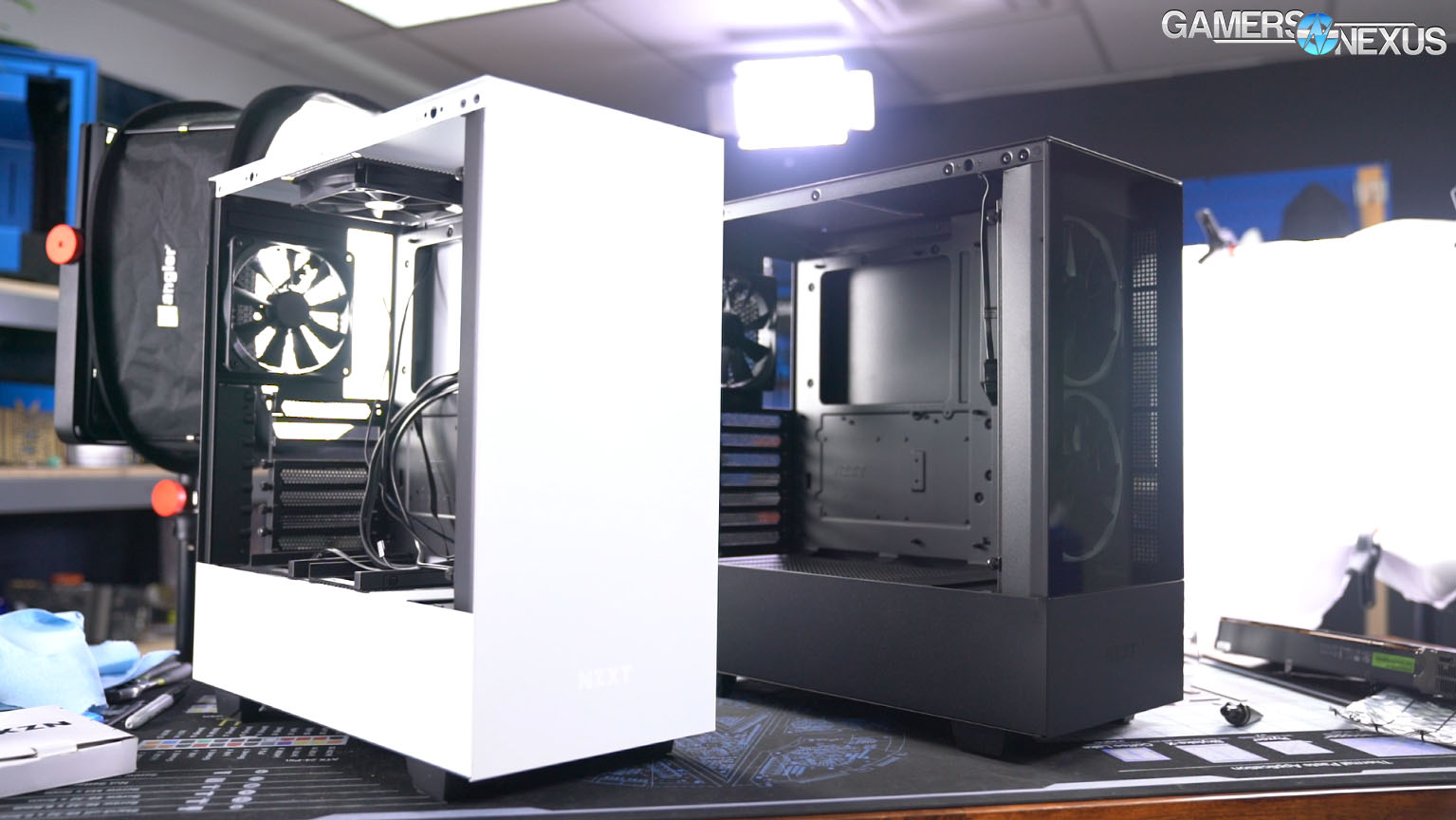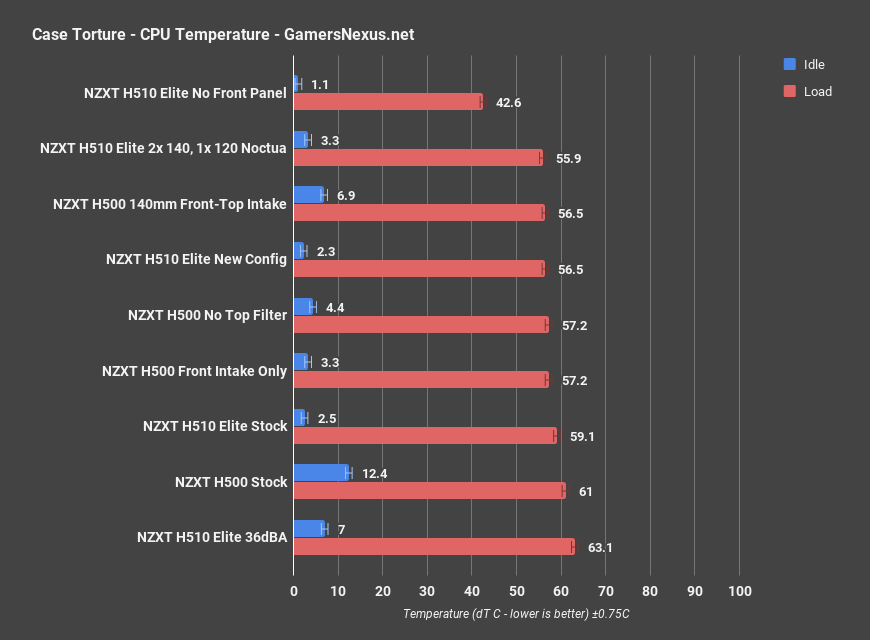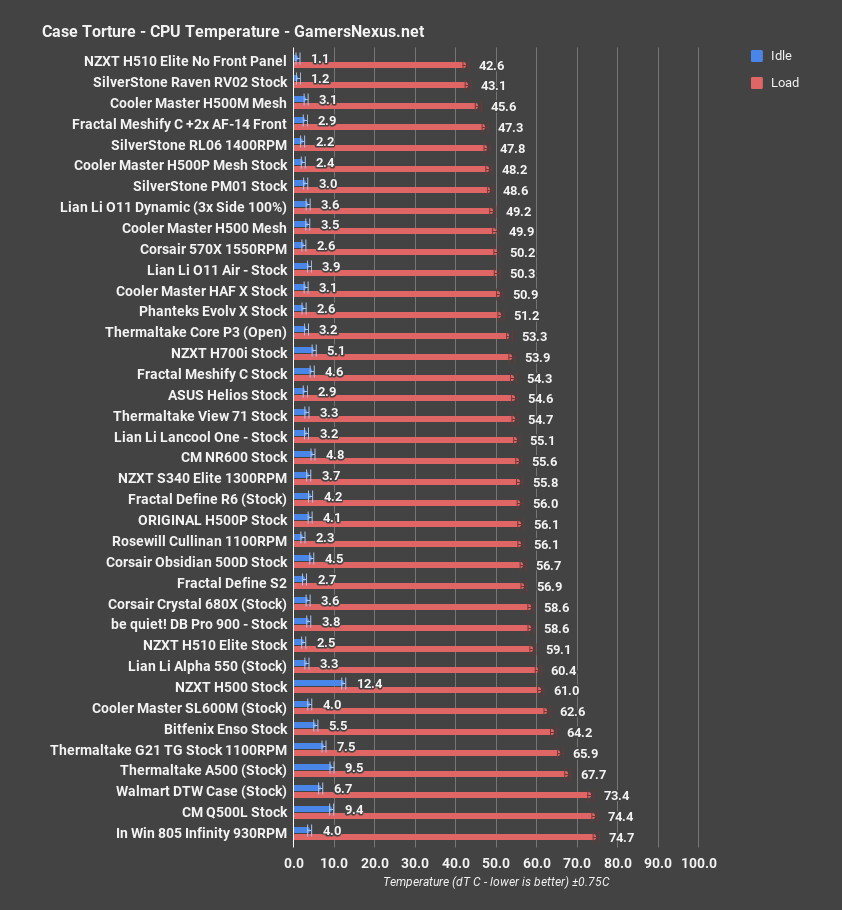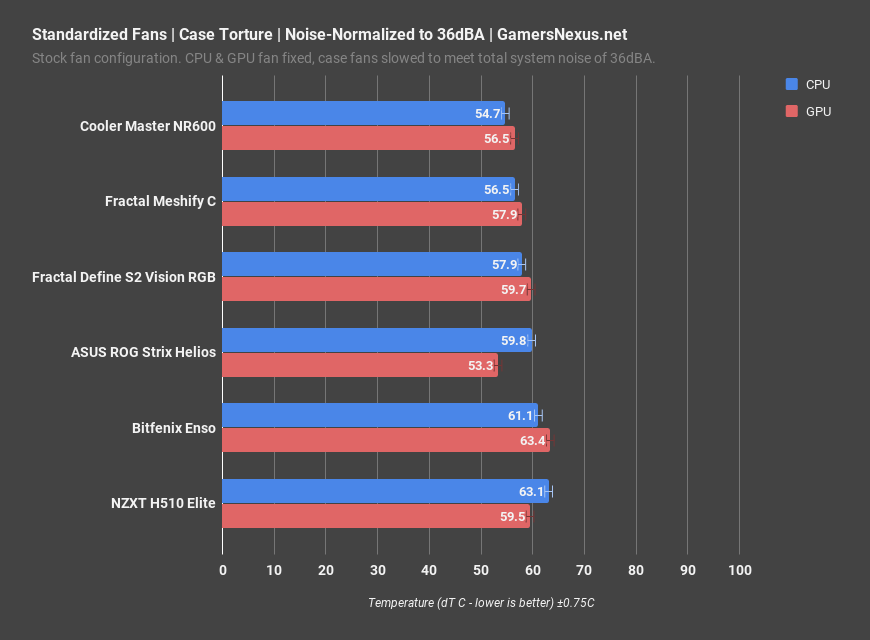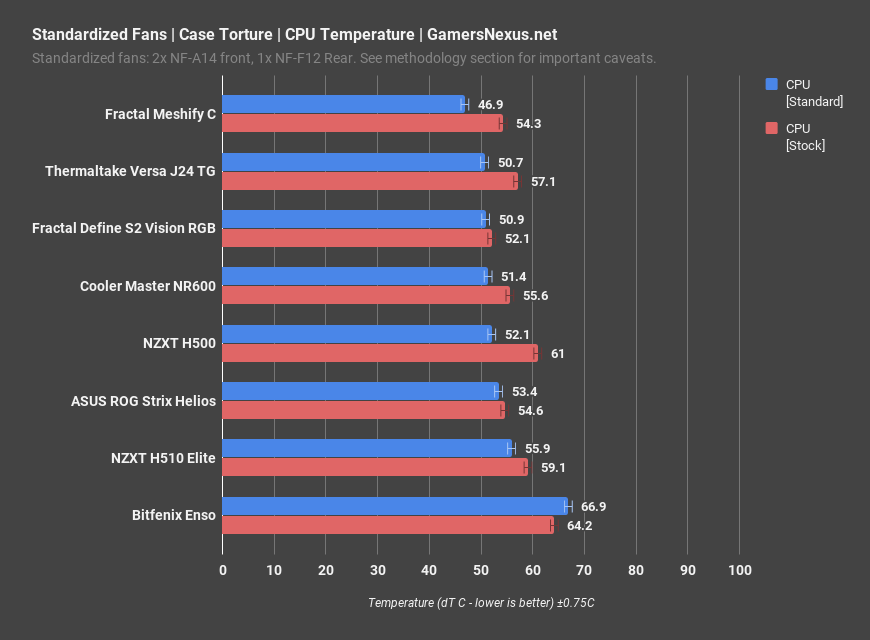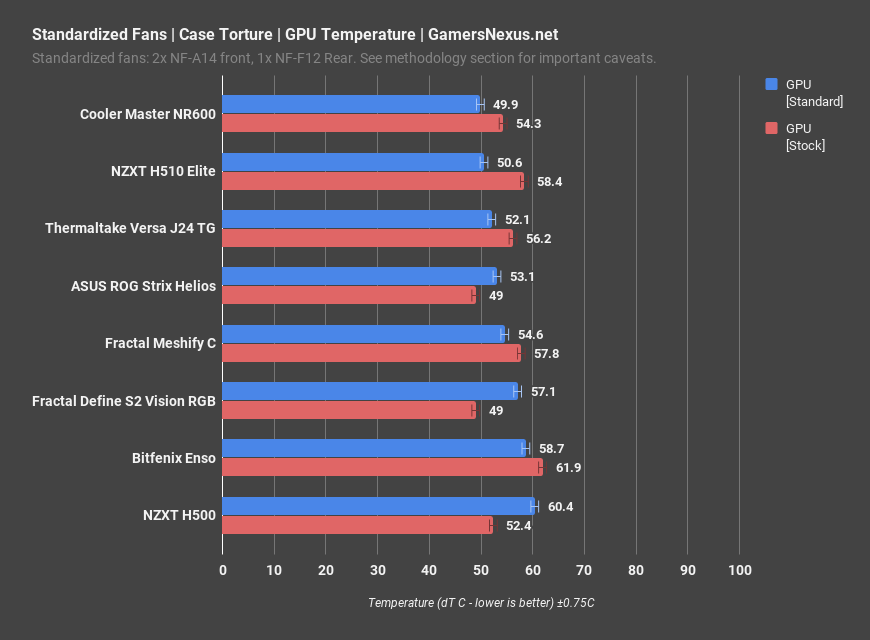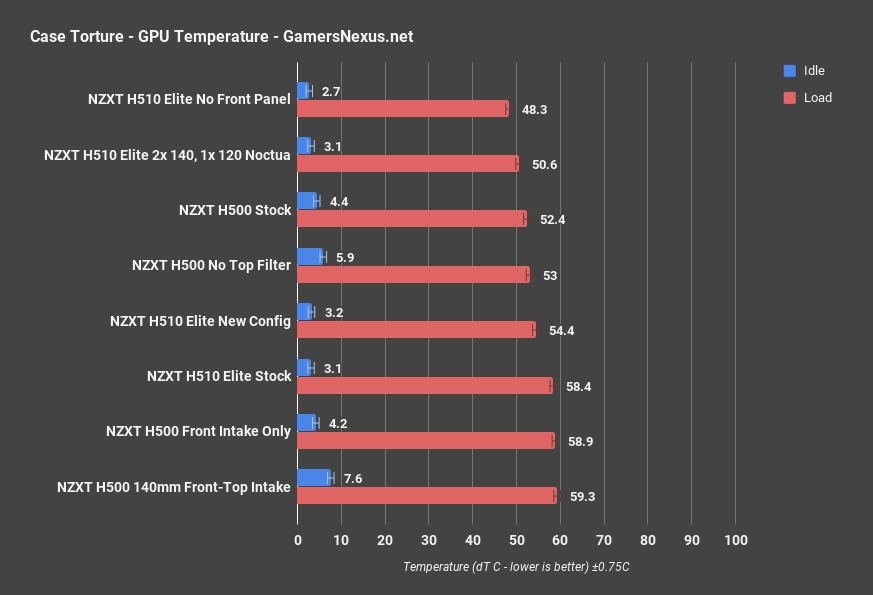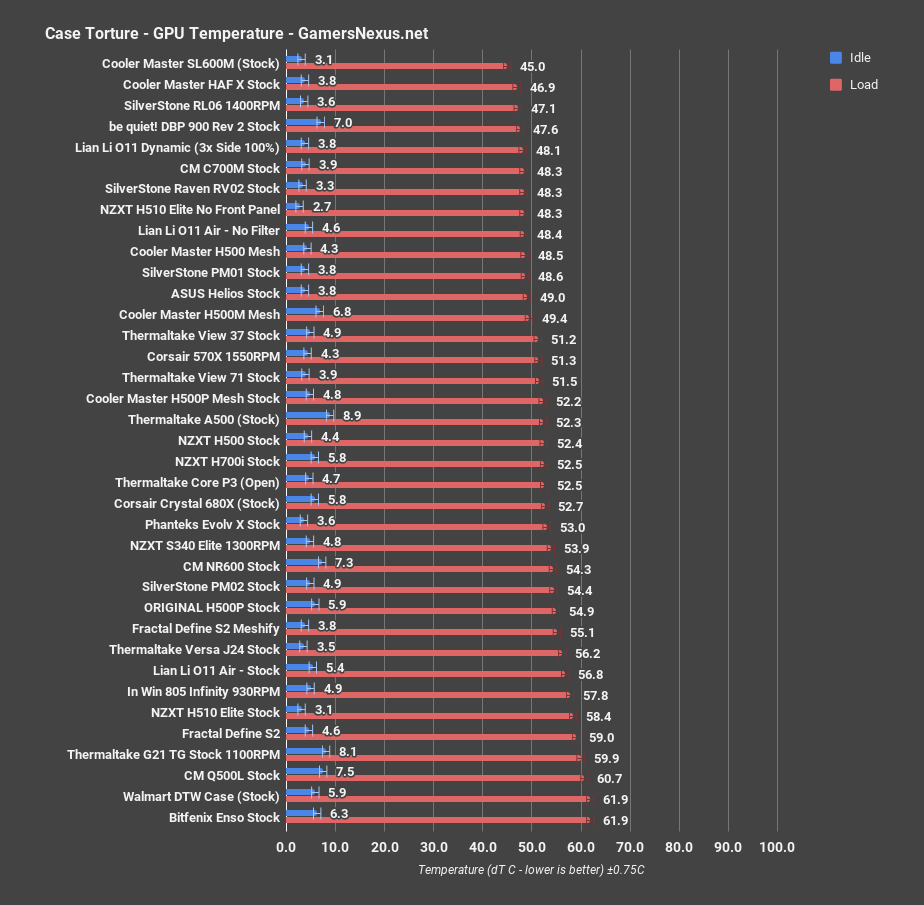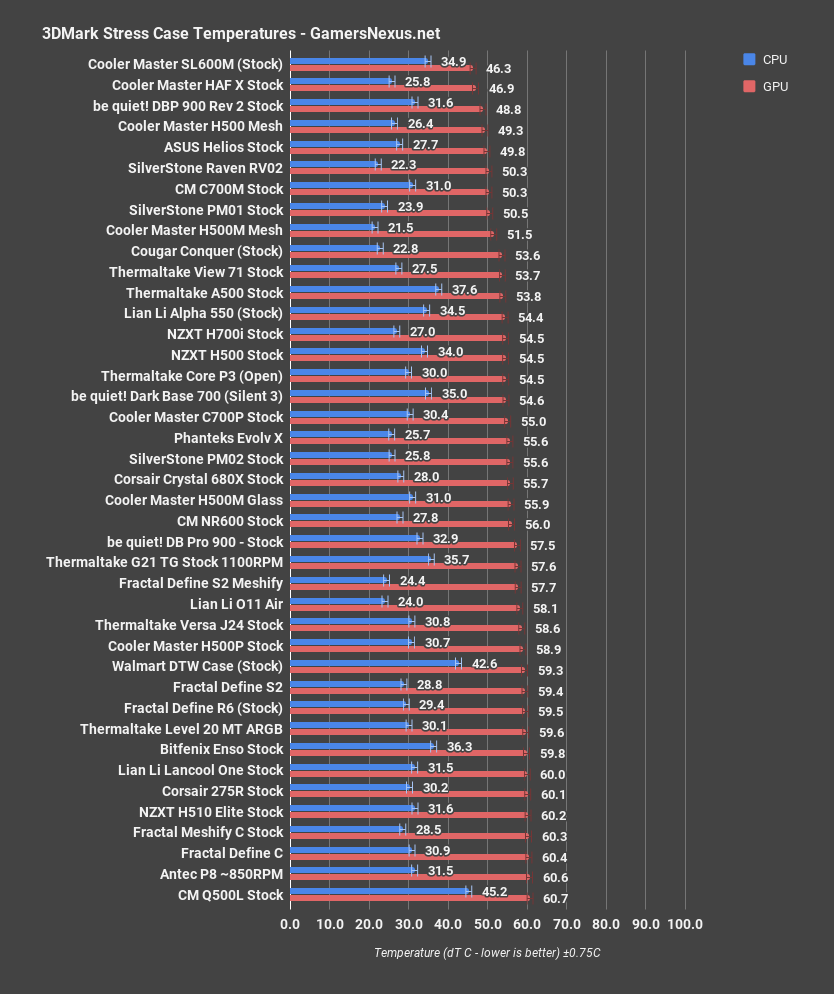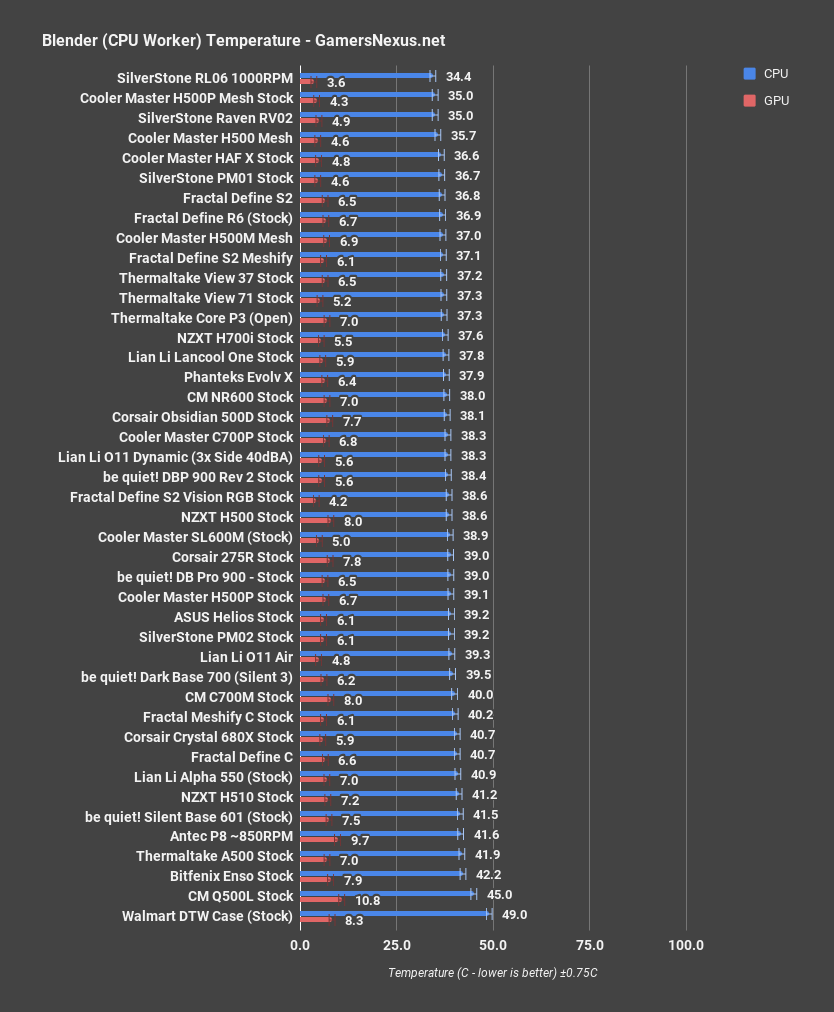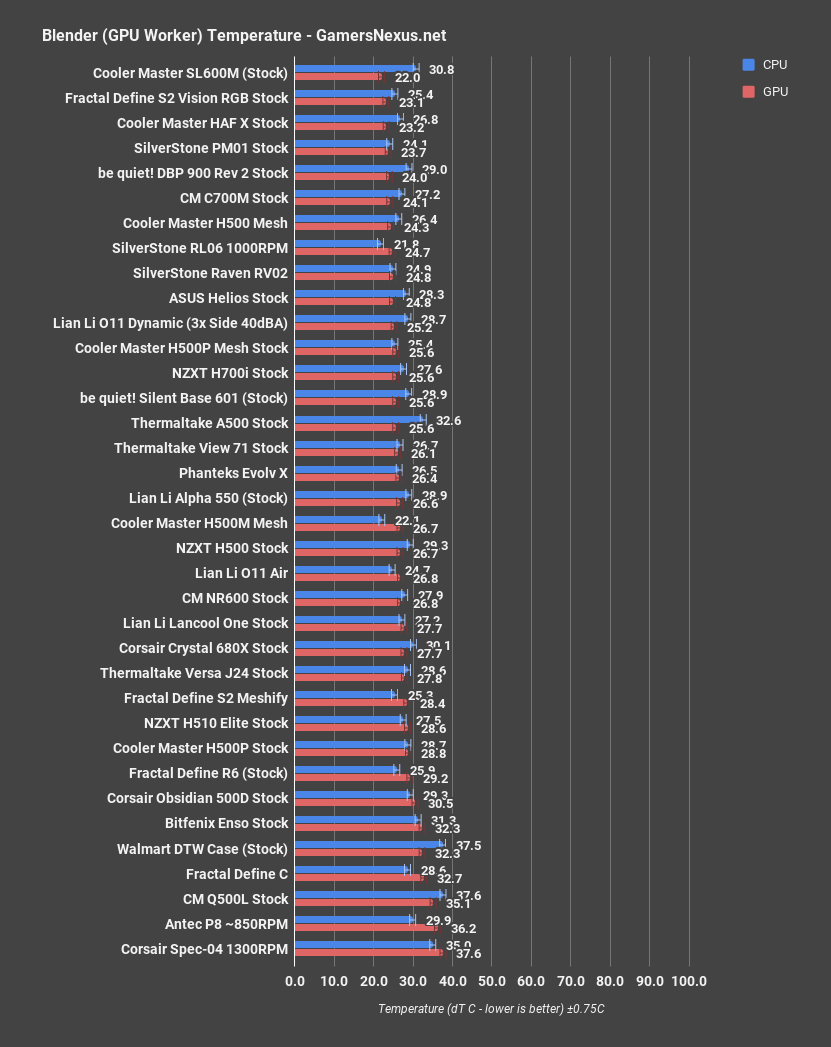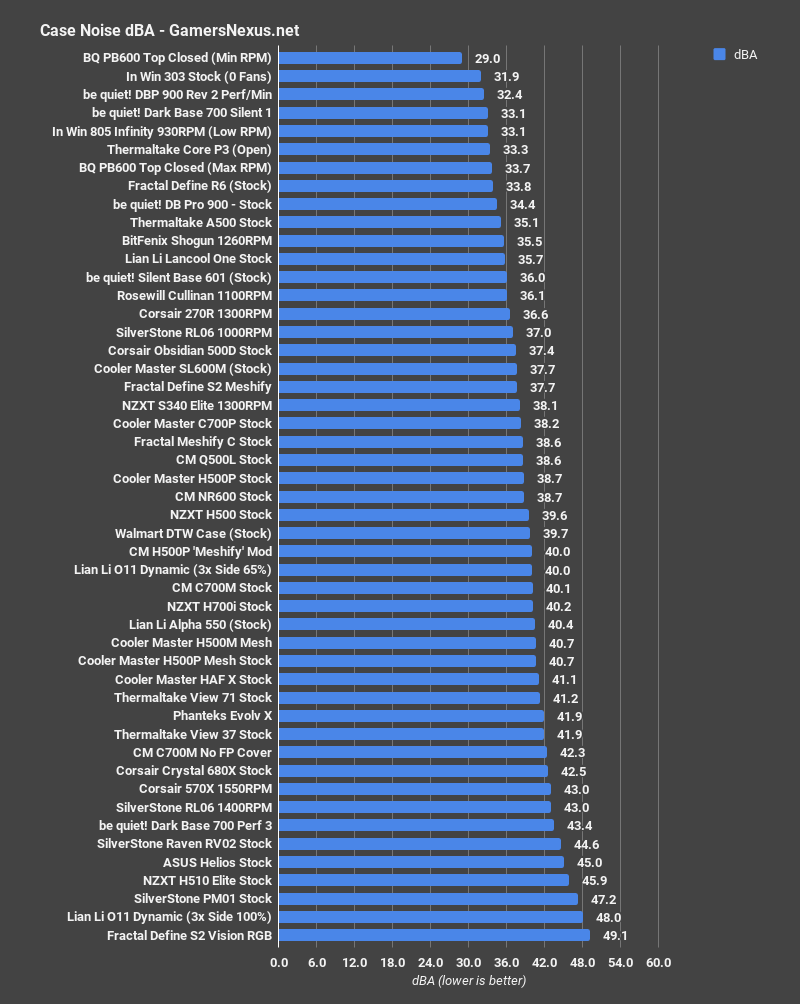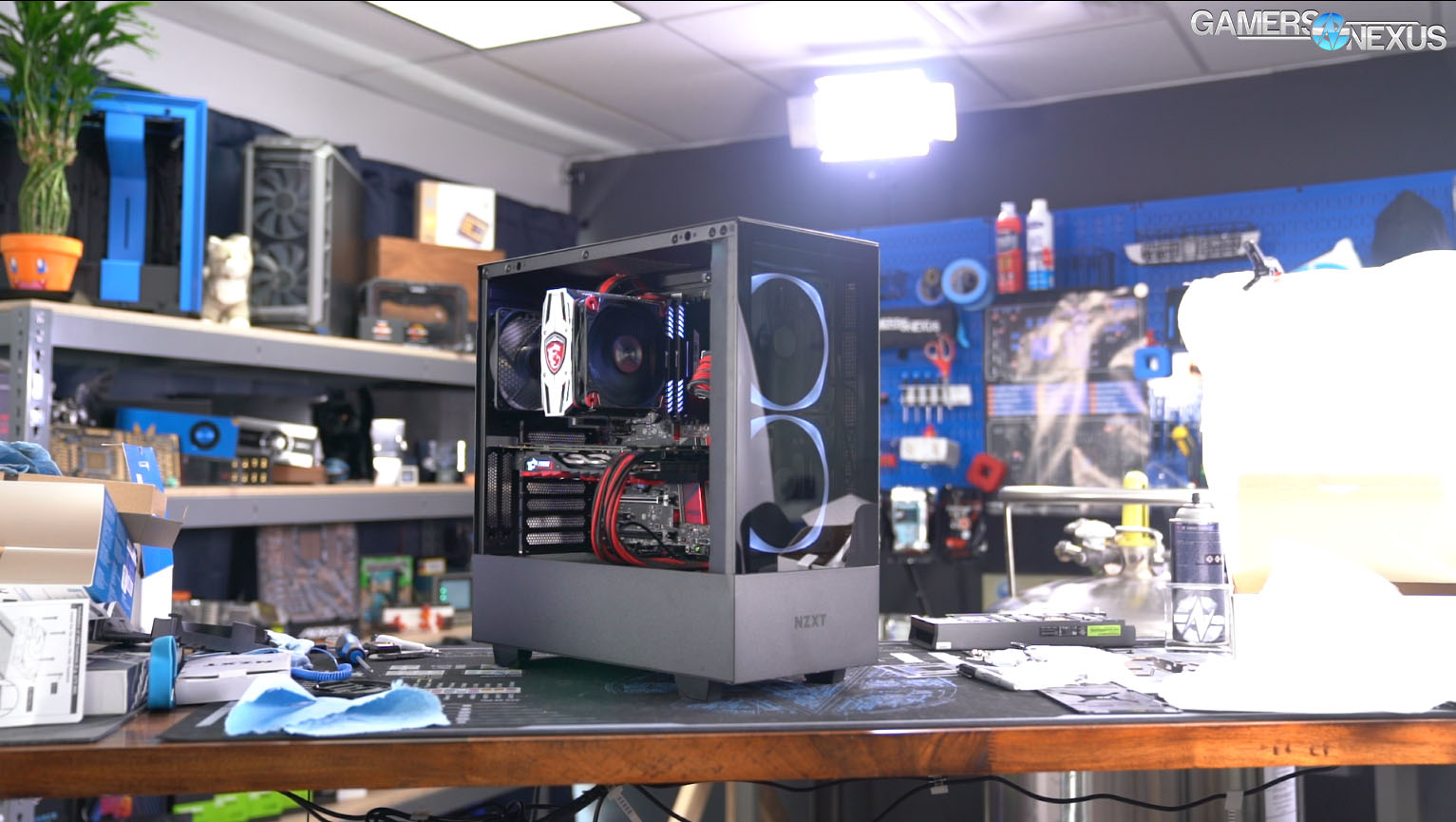The NZXT H510 Elite is NZXT’s premium spin on the H500 -- no, not the Cooler Master H500, not the H500P, not the H500M, and definitely not the 500D or A500, but the NZXT H500. NZXT’s H500 is a case that wasn’t top-of-the-line in thermal performance but that we liked anyway for its good build quality at a very reasonable $70 price point and reasonable thermals. NZXT must be proud of the new H510 Elite, because they sent us two identical ones. The H510 Elite is being introduced alongside the H510, which is the same as the H500, but with a USB type-C port replacing one of the type-A ports on the front pane. It’s also similar to the H510i, which includes an NZXT “Smart Device.” The Elite has a tempered glass front panel, LEDs, and two RGB fans as front intake (3 fans total) as well as the USB-C port and Smart Device. We’ve expressed our opinion on these devices before, intended to automatically run fans at the optimal cool-and-quiet speed, but these new devices are version 2. We plan to do some more testing with them soon, but for the purposes of this review we bypassed the smart device completely and controlled fan speed via the motherboard as usual.
For the purposes of this review, we’re going to pretend no other cases named H500 exist. If we say H500, we mean the NZXT H500. Note also that we had written and filmed this about 3 weeks prior to publishing, but notified NZXT in between writing and now that we had found issues with thermals in the case. As such, NZXT has modified its listing and now offers an extra 120mm exhaust fan (free for those who already bought the case) with the enclosure. We didn’t rewrite our entire review around this change, but added in two charts to cover it where necessary.
NZXT H510 Elite Build
We’ll keep the build section brief, since the Elite is in many ways identical to the base H500 we reviewed more than a year ago. The design and construction of the case remain good. NZXT has found a mix of plastic snaps and captive thumbscrews that makes the case easy to open and take apart but still solid enough to be moved around; one exception to this was the front panel, which has two tiny Philips head screws locking it in place--they keep the panel firmly mounted, but it does mean a tool is required for taking off the front pane of tempered glass as opposed to the toolless disassembly of the other panels.
The case we used for review had one small manufacturing defect, where one of two thumbscrews holding the fan tray into the case had been overtorqued to the point that it deformed the chassis and made the screw tilt sideways. We’re in a unique position with this review since we were accidentally sent two identical cases, and checking the other revealed that both thumbscrews in that case had the same problem. NZXT has been overtightening its screws for years, at this point, since before the S340. Despite the defect, the fan tray is still a good feature and easy to work with. The metal of the PSU shroud is also bowed out slightly where the glass hooks under it, but that may be intentional.
Front I/O is simplified from the original H500. The original had an HDD activity light, a mic jack, a headphone jack, two USB type-A connectors split from a USB 3.0 header, and the power button/LED. The H510 Elite has a combined mic/headphone jack, one USB C 3.1 Gen 2 port, one USB A port, and the combined power button/power LED/HDD LED. We’ve complained a little about combining mic/headphone jacks in the past, but NZXT has included an adapter cable that splits into two normal jacks. The USB type A port on the Elite is 3.1 Gen 1, the same kind as on the H500, and it uses the same full-size USB 3 header on the motherboard end--it just leads to one type A port instead of two. We use USB 3.1 type A ports every day in this office, but we have yet to use a male/male USB C cable ever. The top of the Elite looks nice and clean, but cutting I/O options isn’t a premium feature. The FP connections have been consolidated into one plug, which makes sense now that motherboard manufacturers have almost completely standardized the front panel pinout. A splitter is included in case of non-standard pinouts.
We plan to test the Smart Device v2 in the future, but again, we skipped it for this review since our thermal tests rely on being able to control fan speeds. That means we also skipped all case and fan LEDs, since they’re controlled by the smart device which is in turn controlled by NZXT’s CAM software. There are arguments to be made for software versus mechanical control for LEDs, but the bottom line is that anyone who doesn’t want to deal with the smart device or CAM can just buy an H510 and set up their own LEDs (without the tempered glass front panel). Our only concrete complaint about the device so far (other than increasing the cost of the case) is that it’s mounted so that the latches on the LED plugs are underneath, against the motherboard tray, so that it’s difficult to disconnect any cables from it. The Smart Device uses a USB 2.0 header for communication with the motherboard.
The SSD trays work the same way they did in the H500, clipping into either the ventilated surface of the PSU shroud or hidden away behind the motherboard tray. The difference is that they’re a much cheaper design: the original SSD trays were an overbuilt design assembled from multiple parts with metal springs inside, whereas the new ones are just single pieces of plastic. Again, they’re functionally identical, just different. The HDD cage underneath the PSU shroud is movable and removable, unchanged from the H500 but still a feature worth praising. The H510 Elite has a small metal shield blocking the gap between the top of the HDD cage and the PSU shroud, perhaps to keep the intake fans from pulling hot air from inside the PSU shroud. Renders of the base model H510 (which doesn’t come configured with intake fans) don’t show this shield.
The Elite adds a vertical GPU mount to the side of the normal horizontal ones present in the H500 and the H510. Obviously the chassis wasn’t originally meant to support vertical GPU mounting, so the layout is a little tricky--installing a GPU in the normal horizontal slots requires removing the frame that holds the vertical slots and then replacing it afterwards. We didn’t test the vertical mount this time, but it’s as close to being flush with the glass side panel as any we’ve tested in the past, so we can tell you with certainty that installing an air-cooled GPU in this slot like the one NZXT shows on their product page is a bad idea. Don’t do it.
NZXT H510 Elite Thermals & Noise
Before we reviewed the original H500, NZXT went out of its way to tell us that the dual-fan, dual-exhaust configuration would work better than we expected, and NZXT was right. It wasn’t amazing, but it did the job at least as well as any other arrangement of the two stock fans we could come up with -- at least, when considering the GPU part of the equation. They’ve stuck to that stock fan arrangement with the H510, but the H510 Elite has a glass front panel and a different fan layout. We get the feeling the thought process for the Elite moved backwards, from “we need a premium version of this case” to “we need to put more tempered glass in” to “we need to put some RGB fans behind this tempered glass.” Therefore it has two 140mm Aer RGB 2 intake fans in the front and one 120mm Aer F120 exhaust fan in the rear, the usual case fan layout, but in a case with unusually limited front ventilation. We’ll discuss the thermal results in a moment, but the noise was also affected. We heard loud gusts of turbulence that had us double-checking our charts to make sure the fan speeds were locked, and this noise persisted even with the fans running below max speed. For noise normalized testing we had all the case fans set to 50% speed, which was slow enough that they quieted down. This may be an issue with the fan blade design or a combination of the case and the fans, but the turbulent behavior does create an unsteady noise, which most users find more annoying than a loud, predictable noise.
We didn’t go beyond the standard batch of tests for this one; for more fan configurations, check our original H500 review, since the chassis is effectively identical. We ran tests with the case noise normalized to 36dBA, without the front panel, and with our standardized fan layout. The standardized fan layout is three Noctua fans we’ve reserved for case testing, two 140mm front intake and one 120mm exhaust. Since the H510 Elite is already configured this way, the only difference from stock is the type of fan.
GN Case Testing Bench
| Component | Courtesy Of | |
| Video Card | MSI GTX 1080 Gaming X (OC Mode) | MSI |
| CPU | Intel i7-6700K @ 4.4GHz | GamersNexus |
| CPU Cooler | MSI Core Frozr L | MSI |
| Motherboard | MSI Z170A Gaming M7 | MSI |
| Memory | Corsair Vengeance LED 32GB 3200MHz | Corsair |
| SSD | Samsung 850 EVO 120GB | Samsung |
| PSU | Corsair RM650x | Corsair |
| Cables | CableMod Pro Mesh Cables | CableMod |
| Case | This is what we're testing! | - |
The video card is configured to run at 55% fan speed at all times.
Prior to load testing, we collect idle temperature results for ten minutes to determine the unloaded cooling performance of a case's fans and air channels. Thermal benchmarking is conducted for 1400 seconds (23 minutes), a period we've determined sufficient for achieving equilibrium. The over-time data is aggregated and will occasionally be compiled into charts, if interesting or relevant. The equilibrium performance is averaged to create the below charts.
Load testing is conducted using Prime95 LFFTs and Kombustor “FurMark” stress testing simultaneously. Testing is completely automated using in-house scripting, and executes with perfect accuracy on every run.
Torture CPU
Before diving in, just a quick reminder that we published an update to our case testing methodology back in June. We are now testing noise-normalized for cases going forward, setting all cases to the same noise level with their stock fans (since that is what they ship with), and we also test with a standardized set of fans. This latter test, the standardized one, has several flaws that made us resist adopting the testing, but too many viewers requested it and so we added it. We just want to note that, again, it’s really not the best way to compare things, but it’s commonly requested.
We’ll start our thermals with just the NZXT H500 series in torture CPU tests, then move to comparative tests versus other cases.
Baseline for our CPU during the torture test was 59.1 degrees Celsius dT over ambient, which lowered to 55.9 degrees dT with standardized fans. A three-ish degree difference isn’t too bad considering that this test replaced the stock case fans 1:1 with higher quality Noctua fans; the fans NZXT is packing in with the case are good enough to keep, from these findings. Noise-normalizing the fans by limiting them to 50% speed bumped CPU dT up to 63.1 degrees over ambient, but still not so high that it was forced to throttle. Removing the front panel to allow the fans to actually pull some air dropped temperatures by a ridiculous amount, pushing the CPU down to 42.6 degrees over ambient, a precipitous 16.5-degree drop. We’ve never seen a fall this hard from removing the front panel. Even extremely well-ventilated cases will show improvement with the front panel removed, but we test it to see how close the stock case configuration matches an ideal scenario without filters or glass in the way. There are two ways to look at this result: the H500 and H510 (non-Elite) only have two rear fans and don’t allow the front panel to be removed at all, so removing the front panel of the H510 Elite and pointing out how much it limits the three good-quality stock fans feels like punishing the case for positive features NZXT has added. On the other hand, putting a couple good intake fans in a case that can’t benefit from them is a failed attempt at a value-add. NZXT added glass and realized it needed to fight its own decision, and rather than retool the case, this was the solution.
The previous H500 case was warmer when stock, at 61 degrees, so mission accomplished in improving that, even though it was at the cost of $100 MSRP.
Comparatively, 59.1 degrees Celsius is relatively warm, at the upper-end of the cases we’ve tested that haven’t gone completely out of control thermally. It lands between the Dark Base Pro 900 and the Lian Li Alpha 550, both good cases in their own way but neither known for their cooling capability. Unfortunately, it’s not much better than the stock H500, which averaged 61 degrees dT.
A quick note on this, too: We produced this entire review with the case as it was sent, but after notifying NZXT pre-publication of issues with thermals, the company noted that it would offer a free 120mm extra exhaust fan. That’s good for users, but obviously means that we have to modify our review now since the product has changed. We don’t like companies to get into the habit of making changes after sending out review samples, but it’s still better than shipping a worse product. Anyway, we only have two charts with the updated config -- those will be the standalone H510 charts. The rest of the review will be unedited to reflect our original opinions and original data before NZXT’s change. The extra 120mm fan brings CPU temperature down to 56.5 degrees, which is similar to our 3-fan standardized config. It’s still tremendously suffocated by the rest of the configuration, as the original three-fan setup operated a 43 degree CPU temperature with no front panel, but it’s better by about 2.6 degrees Celsius. This doesn’t really change the review on the whole as it isn’t a massive shift, but it’s still important to note.
Noise-Normalized CPU Thermals
Our noise-normalized chart is still limited, but 63.1 degrees dT pushes the H510 Elite past the Bitfenix Enso, our previous hottest case. When leveled-out to 36dBA, we can better analyze how efficiently a case performs while all operate at a fixed noise level and without any modifications. This shows the value for the dollar when eliminating the ability for a case to brute-force its performance to the top. The turbulent noise forced us to push fan speeds down further for the H510 Elite than we otherwise would have. GPU thermals land the H510 Elite at 59.5 degrees over ambient, putting it about the same as the S2 Vision RGB and not too distant from the Meshify C. Not a terrible place to be on the GPU, and that follows-up the H500’s previously interesting and surprisingly complex GPU airflow pathways. CPU thermals have the 510 Elite in last place, which is obviously a sub-optimal placement for a product.
Standardized Fans
The next charts show standardized fan placement, also a new set of charts for us. Standardizing the fans kept the CPU thermals in the H510 Elite well below the Enso in temperatures, at 56 to 67 degrees over ambient, so the airflow isn’t inherently worse in the Elite--it’s just loud. That’s not surprising, really, seeing how the Enso is a scale model of the heat death of the universe. Even still, the H510 Elite is warmer than everything else, including the original H500. Part of the reason is that we mounted the standardized fans on the inside of the fan tray for the H500 to allow as much room as possible between the fans and the front panel, but we mounted them in front of the tray in the H510 Elite. That’s the way the stock fans are installed and the way the fan tray is designed to be used in the Elite, because otherwise the tray would be between the RGB fan LEDs and the glass front panel.
GPU thermals with standardized fans gets tricky. This is where we don’t particularly like this approach to testing, as discussed in previous content. The trouble is that the H500 -- the original -- and cases like it might perform better with the stock fan configuration than with our more powerful configuration. That’s because it’s not the fans that matter, ultimately, it’s the fan placement and the airpath. In the H500, front fans caused the GPU to suck in its own exhaust from the back of the case, as the pressure setup changed from negative to positive. For the H510 Elite, we don’t see that result because the case starts with a positive pressure configuration. The H510 Elite does well here when standardized, placing similarly to the fine mesh on the Cooler Master NR600. NZXT can make this case work -- it does much better in GPU thermals when standardized than its stock results would lead you to believe.
Torture GPU
Next with GPU torture thermals only, GPU torture temperature averaged 58.4 degrees over ambient, or 50.6C dT with the standardized Noctua fans. We still feel pretty good about NZXT’s stock fans, but the Noctua fans we use for testing definitely have the edge, and are less prone to causing whatever turbulence was making so much noise. Removing the front panel helped almost as dramatically as it did with the CPU thermals, dropping to 48.3 degrees from 58.4 degrees stock -- a reduction of about 10 degrees. There’s a filtered gap under the front panel that means the GPU theoretically has a little more access to cool air than the CPU, but the front panel is still a huge obstacle to airflow.
As mentioned in the earlier edit, this section is also added in after NZXT made its changes. GPU thermals changed to 54.4 degrees with the update, down from 58.4 originally. The change is about 4 degrees. That’s definitely better, but the case overall still has a lot of room for improvement.
Comparative thermals are next for GPUs. Like the CPU temperatures, 58.4 degrees is on the warm side of the comparative chart, right next to the original Define S2. The H510 Elite is near even the entirely closed-off 805 Infinity and the Cooler Master Q500L, which we fixed by drilling stepped holes into. Not good in this one.
Firestrike
FireStrike Extreme is next, basically a gaming workload representation for a realistic look at thermals. 60.2 degrees GPU dT average during the Firestrike Extreme stress test is warmer than the torture test results, and even higher relative to the other cases than the torture result was. It’s definitely hotter than the original NZXT H500, which averaged 54.5C dT in this test and benefited from the unique airflow patterns that we already detailed in our H500 review. The H510 Elite manages to be one of the worst cases we’ve tested for gaming thermals.
Blender CPU/GPU
Blender rendering on the CPU averaged 41.2 degrees over ambient, one of the hottest temps on the chart other than really abysmal performers like the Walmart case. We lock GPU fan speed to 25% speed for the CPU render instead of 55% as we do for the others, so that there’s a minimum of interference with CPU thermals in a realistic CPU-only workload like Blender. The H510 Elite allowed more heat to build up in the top of the case than the NZXT H500, which averaged 38.6C dT thanks to its two exhaust fans.
GPU accelerated rendering in Blender averaged 28.6 degrees GPU dT, which is actually a bit more competitive than the torture and 3DMark results, around the performance level of the Meshify S2. Without the extreme workload of those tests, the intake fans do a passable job at getting enough cool air in to the GPU, although it still runs warmer than the H500’s 26.7dT average.
Noise
We’ve mentioned noise levels several times already throughout the course of this review because of the gusty turbulent noises the fans made at high speeds. At max fan speeds, we measured the case running at 45.9dBA, one of the loudest cases we’ve tested after cases with more fans, like the S2 Vision RGB and Silverstone PM01. It’s possible that other users with other components and configurations might not experience the weird noises we did. Airflow is complex.
NZXT H510 Elite Conclusion: Not Worth It
The H510 Elite is a $170 case being launched alongside an $80 case that’s nearly identical, which itself is almost identical to a $70-$75 case that it’s replacing. The main differentiating feature is the NZXT Smart Device v2, and the fact that we haven’t even mentioned the existence of the H510i might give you a clue as to how we feel about that. We thought the H500 was a good buy at $70, and from what we’ve seen of the H510 it probably will be too--or $80, since that’s MSRP. Customers should strongly consider buying one of those instead and using the extra $90-$100 to choose their own fans or LEDs. If a clear front panel with RGB fans and disappointing thermal performance is an absolute necessity, buy a Level 20 MT instead and save some money.
Host, Test Lead: Steve Burke
Testing, Editorial: Patrick Lathan
Video: Andrew Coleman, Josh Svoboda
